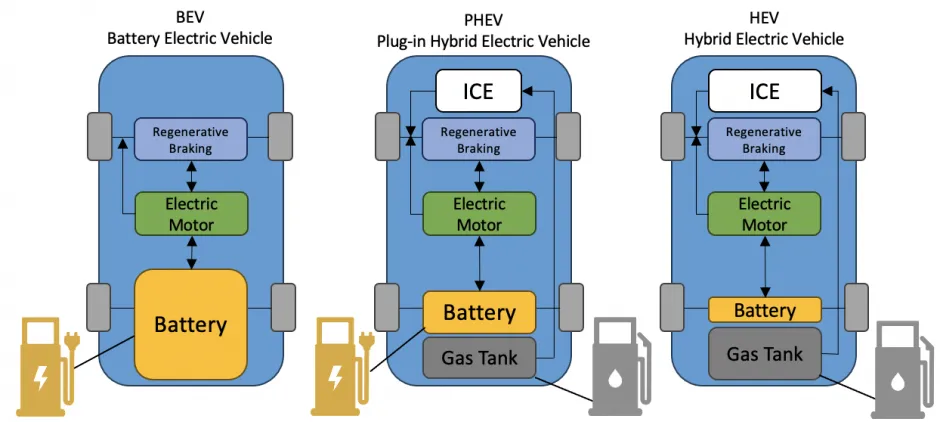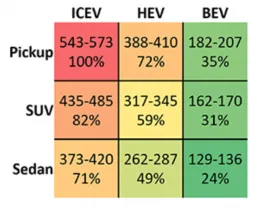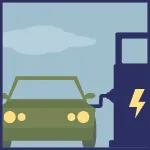Electric Vehicles Factsheet
Types of Electric Vehicles
- Not all vehicles that use electricity are called EVs—some vehicles use liquid fuels in conjunction with electricity.1
- Hybrid electric vehicles (HEVs) use an internal combustion engine (ICE) and one or more electric motors and energy stored in a battery. Unlike in pure EVs and plug-in hybrid electric vehicles (PHEV) this battery is charged by the ICE and regenerative braking rather than by plugging in.1
- Plug-in hybrid electric vehicles are powered by an ICE but PHEV batteries can also be charged from the grid, enabling the vehicle to run on liquid fuels and in all-electric mode. PHEVs can typically travel between 20 and 40 miles solely on electricity before switching to gasoline.1
- Battery electric vehicles (BEVs) are powered exclusively by an electric motor and onboard battery that is usually recharged from the grid.1
- BEVs achieve their best travel range in moderate temperatures and offer better range in cities due to regenerative braking.2
- BEVs have no tailpipe emissions, although the grid from which they draw electricity is likely to be responsible for emissions.3
- Fuel cell electric vehicles (FCEVs) convert energy stored as hydrogen into electricity using a fuel cell. Similar to BEVs, FCEVs produce no harmful tailpipe emissions, emitting only water vapor, oxygen, and heat; their impact is dependent on the process used for hydrogen production.4
- • Vehicles that produce no emissions from the onboard source of power—including BEVs and FCEVs—are called zero emission vehicles (ZEV).
Battery Electric Vehicle Technologies
Since BEVs run only on electricity, they do not include liquid fuel components or exhaust systems.5
- Electric Traction Motor drives the vehicle wheels using energy from the traction battery pack. All EVs use electric motors that have both drive and regeneration functions.5
- Traction Battery Pack stores electricity for use by the electric traction motor.5
- Battery size, chemistry, and vehicle efficiency determine the range of the vehicle with current BEVs having a range between 110-520 miles.1
- BEVs typically use three types of lithium-ion batteries: lithium manganese cobalt oxide (NMC), lithium iron phosphate (LFP), and lithium nickel-cobalt-aluminum oxide (NCA).1 LFP is gaining in market share due to lower cost.6
- Charge Port allows the vehicle to connect to an external power supply to charge the traction battery pack.5
- BEVs can be charged using electric vehicle service equipment (EVSE) at different charging speeds. Level 1 (approx. 5 miles of range per 1 hour 120 V charging) equipment can take 40-50+ hours to charge a BEV from empty to 80%. Level 2 (approx. 25 miles range per 1 hour 240 V residential or 208 V commercial charging) equipment can charge a BEV from empty to 80% in 4-10 hours. Direct current fast charging (DCFC) equipment (approx. 100 to 200+ miles of range per 30 minutes of charging, typically a three-phase AC input) can charge a BEV from empty to 80% in 20 minutes to 1 hour. Level 2 and DCFC equipment are deployed at many public locations.7,8
Electric Vehicle Technologies
Image

Current Market
Market Leaders
- In December 2010 BEVs accounted for 0.002% of light-duty vehicles sold in the U.S., while in May 2023 they accounted for 6.6%.9
- In the first half of 2023, Tesla led the market with 336,892 BEV sales in the U.S. Following Tesla were Hyundai-Kia, General Motors, the Volkswagen Group, and Ford with 38,457, 36,322, 26,538, and 25,709 in BEV sales in the U.S. respectively.10 Globally, Tesla led the market with BYD second.11
- Global spending on EVs exceeded $425 billion in 2022, 10% of spending was attributed to government support through direct purchasing incentives with the rest coming from consumers.6
- Electric light commercial vehicle (LCV) sales increased over 90% in 2022 to more than 310,000 vehicles even as total LCV sales declined 15%.6
- China accounted for 60% of global EV sales with Europe and the U.S. making up 10% and 8% of the global sales share respectively. Over half of the world’s EVs are in China.6 In 2022, Norway was the global leader with a 79% share of the country’s new light duty vehicle (LDV) sales as EVs.12
Policies and Incentives
- In 2021 President Biden set a target to make 50% of all new LDVs ZEVs by 2030.13
- Under the Inflation Reduction Act, the Clean Vehicle Credit qualifies taxpayers who purchase eligible new electric vehicles in 2023 for a federal income tax credit up to $7,500.14
- Taxpayers who purchase eligible used EVs from a licensed dealer for $25,000 or less may be eligible to receive a tax credit of up to $4,000.15
- Businesses and tax-exempt organizations that purchase a qualified commercial vehicle may be able to take a clean vehicle tax credit of up to $7,500 for vehicles under 14,000 lbs and $40,000 for all other vehicles.16
- The Alternative Fuel Vehicle Refueling Property Credit was extended until December 31, 2032. It allows taxpayers to claim up to $1,000 for EV charger and hardware installation.17
- California, Oregon, and Pennsylvania have incorporated equity aspects into EV incentives to address needs of low-income individuals, those living in air pollution districts, and disadvantaged communities.18
- The California Air Resources Board (CARB) has implemented income caps and MSRP caps to target incentives at those who need them most. Oregon offers up to $2,500 for the purchase of new EVs, with an additional Charge Ahead rebate of $2,500 for qualifying low or moderate income households. Low-income buyers in Pennsylvania receive an additional $1,000 rebate in addition to the $750 state rebate for BEVs.18
Current Limitations and Barriers
- As range anxiety concerns have hindered consumer buy-in, the U.S. Department of Energy (DOE) has committed to expanding charging infrastructure and improving battery capacity.19
- Most of the critical minerals used in BEVs are concentrated in electric motors (neodymium, praseodymium, and dysprosium) and batteries (lithium, cobalt, manganese, nickel, and graphite).20
- Permanent-magnet motors are the most commonly used type in electric vehicles. They can contain 0.06-0.35 kg rare earth elements along with 0.25-0.50 kg neodymium, 3-6 kg copper, 0.9-2 kg iron, and 0.01-0.03 kg boron per vehicle.20
- Lithium-ion batteries contain minerals such as lithium, nickel, cobalt, manganese, graphite, and copper.20 As a result of these mineral-intensive components BEVs use approximately six times more minerals by mass than ICE vehicles.20
- Lithium recycling infrastructure could ease the strain on the supply chain, but the non-standardization and lack of regulation for lithium-ion batteries paired with the cost of keeping recycling plants operational in the developing supply chain make recovering lithium a difficult task.21,22
- Lower income households experience the highest BEV energy burdens, or portion of income spent on energy services, as 96% of households with incomes less than 30% of area median income would experience moderate or high BEV burdens.23
Impacts, Solutions, and Sustainability
- While BEVs have roughly double the greenhouse gas (GHG) emissions of ICE vehicles in the production phase of their lifecycle due to emissions during battery production, they have lower use phase emissions across vehicle types. Consequently, total life cycle GHG emissions for new BEVs are 57% lower compared to the same ICEVs (pickup truck, SUV, sedan) on average across the U.S.24,25
- Use phase GHG emissions are dependent on charging location (grid fuel mix, temperature, etc.)See 25 for U.S. map
- To maximize battery life, BEV owners should minimize exposure to high and low temperatures, time spent at 100% or 0% state of charge, and fast charging (level 2 charging creates less battery degradation).26
- In addition to GHG benefits, BEVs do not directly emit PM, NOx, and other pollutants that contribute to local air pollution that disproportionately impacts lower income communities.
- BEVs typically have higher purchase prices than ICEVs, but lower maintenance and fuel costs (cost of electricity needed to charge vs. gasoline). The total cost of ownership is favorable towards BEVs for smaller vehicle classes, and when owners have high annual mileage and have access to home charging. Home charging is significantly less expensive than public charging.27
- There are 59,758 electric charging stations in the U.S. with a total of 161,118 EVSE ports as of 2023, compared to about 145,000 gas stations.28,29
- Most charging stations are located near the coasts and urban centers, which has led to charger availability concerns.28,30 To ease these concerns, Ford and GM made an agreement with Tesla allowing owners of their EVs to use 12,000 of Tesla’s DC fast chargers across the U.S. and Canada starting in spring 2024.31,32
- Despite range anxiety, 25-37% of the vehicle population can meet trip needs using a smaller EV battery combined with community charging.33
- The households that are best suited for early EV adoption are those with multiple vehicles, access to an outlet for home recharging, and who do mostly urban, low-speed trips.34
- By 2050 zero-emission vehicles such as BEVs in conjunction with clean power grids could lead to $978 billion in public health benefits, 89,300 fewer premature deaths, 2.2 million fewer asthma attacks, and 10.7 million fewer lost work days.35
- It has been estimated that global automakers expect to spend $1.2 trillion through 2030 on EVs, batteries, and minerals.36
Lifetime GHG Emissions for Each Vehicle Class and Powertrain Combination Averaged Across the U.S.24,25 (g CO2e/mi and average emissions as % of ICEV pickup emissions)
Image

Cite As
Center for Sustainable Systems, University of Michigan. 2023. "Electric Vehicles Factsheet." Pub. No. CSS23-08.
References
- U.S. Department of Energy (DOE) Electric Vehicles.
- U.S. Energy Information Administration (EIA) (2023) Use of energy explained Energy use for transportation Electric Vehicles.
- U.S. DOE, U.S. Environmental Protection Agency (EPA) All-Electric Vehicles.
- U.S. DOE Fuel Cell Electric Vehicles.
- U.S. DOE How Do All-Electric Cars Work?.
- International Energy Agency (IEA) (2023) Global EV outlook 2023.
- U.S. Department of Transportation (DOT) (2023) Charger Types and Speeds.
- U.S. DOE Developing Infrastructure to Charge Electric Vehicles.
- Argonne National Laboratory (ANL) (2023) LDV Total Sales of PEV and HEV by Month (updated through May 2023).
- CNBC (2023) EV sales: Hyundai overtakes GM, but Tesla’s U.S. Dominance Continues.
- InsideEVs (2023) World’s Top 5 EV Automotive Groups Ranked By Sales: Q1-Q4 2022.
- International Council on Clean Transportation (2023) Annual update on the global transition to electric vehicles: 2022.
- The White House (2021) Fact Sheet: President Biden Announces Steps to Drive American Leadership Forward on Clean Cars and Trucks.
- U.S. DOE (2022) Electric Vehicle (EV) and Fuel Cell Electric Vehicle (FCEV) Tax Credit.
- IRS (2023) Used Clean Vehicle Credit.
- IRS (2023) Commercial Clean Vehicle Credit.
- Forbes (2023) The EV Charger Tax Credit Gets A 10-Year Extension - And A Few Upgrades.
- Hardman, S., et al. (2021) A perspective on equity in the transition to electric vehicles.
- U.S. DOE (2022) DOE Announces $45 Million to Develop More Efficient Electric Vehicle Batteries.
- IEA (2021) The Role of Critical Minerals in Clean Energy Transitions.
- IEEE Spectrum (2022) The EV Transitions Explained: Battery Challenges.
- Ma, X., et al. (2021) Li-ion battery recycling challenges. Chem, Volume 17, Issue 11, 2843-2847.
- Vega-Perkins, J., et al. (2023) Mapping electric vehicle impacts: greenhouse gas emissions, fuel costs, and energy justice in the United States. 2023 Environ. Res. Lett., 18 014027.
- Woody, M., et al. (2022) The role of pickup truck electrification in the decarbonization of light-duty vehicles. 2022 Environ. Res. Lett., 17 034031.
- Woody, M., et al. (2022) The role of pickup truck electrification in the decarbonization of light-duty vehicles. 2022 Environ. Res. Lett., 17 089501.
- Woody, M. (2020) Strategies to limit degradation and maximize Li-ion battery service lifetime - critical review and guidance for stakeholders.
- ANL (2021) Comprehensive Total Cost of Ownership Quantification for Vehicles with Different Size Classes and Powertrains.
- U.S. DOE Alternative Fueling Station Locator.
- American Pertoleum Institute Service Station FAQs.
- CBS News (2023) Some electric vehicle owners say no need for “range anxiety”.
- Consumer Reports (2023) Ford EV Drivers to Gain Access to 12,000 Tesla Superchargers.
- Fortune (2023) General Motors is the latest car company to cut a deal with Tesla to use their massive charging network.
- Kempton, W., et al. (2023) Influence of Battery Energy, Charging Power, and Charging Locations upon EVs’ Ability to Meet Trip Needs. Energies 2023, 16(5), 2104.
- U.S. EPA (2023) What If One of Your Cars was Electric.
- American Lung Association (2023) Driving to Clean Air: Health Benefits of Zero-Emission Cars and Electricity.
- Reuters https://www.reuters.com/graphics/AUTOS-INVESTMENT/ELECTRIC/akpeqgzqypr/ 2022
